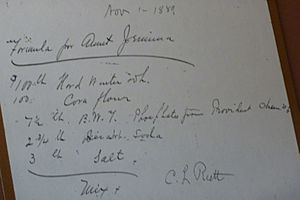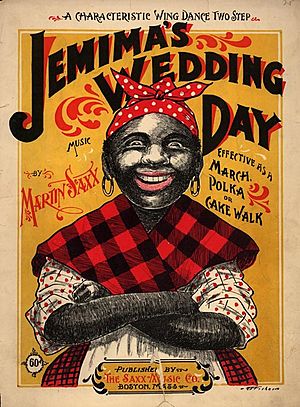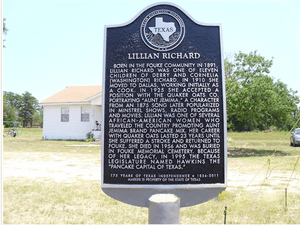Aunt Jemima facts for kids

Logo as of January 2021
|
|
| Owner | Quaker Oats |
|---|---|
| Introduced | November 1, 1889 |
| Markets | Worldwide |
Aunt Jemima is a brand of pancake mix, syrup, and other breakfast foods. The pancake mix was developed in 1888–1889 by the Pearl Milling Company and advertised as the first ready-mix. The Aunt Jemima character is based on the enslaved "Mammy" archetype. The "Aunt Jemima Doctrine" in US trademark law originates in a 1915 case between the pancake mix company and an unrelated seller of pancake syrup. The brand has been owned by the Quaker Oats Company since 1926.
Nancy Green portrayed Aunt Jemima at the 1893 World's Columbian Exposition in Chicago, one of the first Black corporate models in the United States. Subsequent advertising agencies hired dozens of actors to perform the role as the first organized sales promotion campaign.
Since its debut, the character has been criticized as an example of exploited African American women. "Aunt Jemima" is sometimes used as a female version of the derogatory epithet "Uncle Tom" or "Rastus". In June 2020, Quaker Oats announced that the Aunt Jemima brand would be retired "to make progress toward racial equality." They subsequently announced in February 2021 that the line will be re-branded in June 2021 as Pearl Milling Company after the original owners of the pancake mix.
Contents
History
St. Joseph Gazette editor Chris L. Rutt, of St. Joseph, Missouri, and his friend Charles G. Underwood bought a flour mill in 1888. Rutt and Underwood's Pearl Milling Company faced a glutted flour market. After experimenting, they sold their excess flour as a pancake mix in paper bags with a generic label, "Self-Rising Pancake Flour", later dubbed "the first ready-mix". To distinguish their pancake mix, in the autumn of 1889 Rutt appropriated the Aunt Jemima name and image from lithographed posters seen at a vaudeville house in St. Joseph, Missouri.
1889 Formula for Aunt Jemima mix:
- 100 lb [45 kg] Hard Winter Wheat
- 100 lb [45 kg] Corn Flour
- 7+1⁄2 lb [3.4 kg] B.W.T. Phosphates from Provident Chem[ical] St L[ouis]
- 2+3⁄4 lb [1.2 kg] Bicarb[onate] Soda
- 3 lb [1.4 kg] Salt.
However, Rutt and Underwood could not raise enough capital and quickly ran out of money. They sold their company to the Randolph Truett Davis Milling Company (also in St. Joseph, Missouri) in 1890, then the largest flouring mill on the Missouri River, having an established reputation with wholesale and retail grocers throughout the Missouri Valley. Davis improved the flavor and texture of the product by adding rice flour and corn sugar, and simplified the ready-mix by adding powdered milk. Only water was needed to prepare the batter.
The Davis Milling Company was renamed Aunt Jemima Mills in February 1914. In 1915, the well-known Aunt Jemima brand was the basis for a trademark law ruling that set a new precedent. Previously trademarks had only been protected against infringement by other sellers of the same product, but under the "Aunt Jemima Doctrine" the seller of pancake mix was protected against infringement by an unrelated seller of pancake syrup.
The Quaker Oats Company purchased the Aunt Jemima Mills Company in 1926, and formally registered the Aunt Jemima trademark in April 1937. It remains one of the longest continually running logos and trademarks in the history of American advertising.
Quaker Oats introduced Aunt Jemima syrup in 1966. This was followed by Aunt Jemima Butter Lite syrup in 1985 and Butter Rich syrup in 1991.
Aunt Jemima frozen foods were licensed out to Aurora Foods in 1996, which was absorbed into Pinnacle Foods Corporation in 2004.
Character
Aunt Jemima is based on the common enslaved "Mammy" archetype, a plump Black woman wearing a headscarf who is a devoted and submissive servant. Her skin is dark and dewy, with a pearly white smile. Although depictions vary over time, they are similar to the common attire and physical features of "mammy" characters throughout history.
The term "aunt" and "uncle" in this context was a Southern form of address used with older enslaved peoples. They were denied use of courtesy titles, such as "mistress" and "mister".
A British image in the Library of Congress, which may have been created as early as 1847, shows a smiling Black woman named "Miss Jim-Ima Crow," with a framed image of "James Crow" on the wall behind her. A character named "Aunt Jemima" appeared on the stage in Washington, D.C., as early as 1864. Rutt's inspiration for Aunt Jemima was Billy Kersands' American-style minstrelsy/vaudeville song "Old Aunt Jemima", written in 1875. Rutt reportedly saw a minstrel show featuring the "Old Aunt Jemima" song in the fall of 1889, presented by blackface performers identified by Arthur F. Marquette as "Baker & Farrell". Marquette recounts that the actor playing Aunt Jemima wore an apron and kerchief.
However, Doris Witt at University of Iowa was unable to confirm Marquette's account. Witt suggests that Rutt might have witnessed a performance by the vaudeville performer Pete F. Baker, who played characters described in newspapers of that era as "Ludwig" and "Aunt Jemima". His portrayal of the Aunt Jemima character may have been a white male in blackface, pretending to be a German immigrant, imitating a black minstrel parodying an imaginary black female slave cook.
Beginning in 1894, the company added an Aunt Jemima paper doll family that could be cut out from the pancake box. Aunt Jemima is joined by her husband, Uncle Rastus (later renamed Uncle Mose to avoid confusion with the Cream of Wheat character, while Uncle Mose was first introduced as the plantation butler). Their children, described as "comical pickannies": Abraham Lincoln, Dilsie, Zeb, and Dinah. The paper doll family was posed dancing barefoot, dressed in tattered clothing, and the box was labeled "Before the Receipt was sold." (Receipt is an archaic rural form of recipe.) Buying another box with elegant clothing cut-outs to fit over the dolls, the customer could transform them "After the Receipt was sold." This placed them in the Horatio Alger rags-to-riches American cultural mythos.
Rag doll versions were offered as a premium in 1909: "Aunt Jemima Pancake Flour/Pica ninny Doll/ The Davis Milling Company." Early versions were portrayed as poor people with patches on the trousers, large mouths, and missing teeth. The children's names were changed to Diana and Wade. Over time, there were improvements in appearance. Oil-cloth versions were available circa the 1950s, with cartoonish features, round eyes, and watermelon mouths.
Marketing materials for the line of products centered around the "Mammy" archetype, including the slogan first used at the 1893 World's Columbian Exposition in Chicago, Illinois: "I's in Town, Honey".
At that World's Fair, and for decades afterward, marketers created and circulated fictional stories about Aunt Jemima. She was presented as a "loyal cook" for a fictional Colonel Higbee's Louisiana plantation on the Mississippi River. Jemima was said to use a secret recipe "from the South before the Civil War," with their "matchless plantation flavor," to make the best pancakes in Dixie. Another story described her as diverting Union soldiers during the Civil War with her pancakes long enough for Colonel Higbee to escape. She was said to have revived a group of shipwrecked survivors with her flapjacks.
A typical magazine ad from the turn of the century created by advertising executive James Webb Young, and the illustrator N.C. Wyeth, shows a heavyset black cook talking happily while a white man takes notes. The ad copy says, "After the Civil War, after her master's death, Aunt Jemima was finally persuaded to sell her famous pancake recipe to the representative of a northern milling company."
However, the Davis Milling Company was not located in a northern state. Missouri in the American Civil War was a hotly contested slave state. In reality, she never existed, created by marketers to better sell products.
Logo
The earliest advertising was based upon a vaudeville parody, and remained a caricature for many years.
Quaker Oats commissioned Haddon Sundblom, a nationally known commercial artist, to paint a portrait of Anna Robinson. The Aunt Jemima package was redesigned around the new likeness.
James J. Jaffee, a freelance artist from the Bronx, New York, also designed one of the images of Aunt Jemima used by Quaker Oats to market the product into the mid-20th century.
Just as the formula for the mix has changed several times over the years, so has the Aunt Jemima image. In 1968, the face of Aunt Jemima became a composited creation. She was slimmed down from her previous appearance, depicting a more “svelte” look, wearing a white collar, and geometric print "headband" still resembling her previous kerchief.
In 1989, as she marked her 100th anniversary, her image was again updated, with all head-covering removed, revealing wavy, gray-streaked hair, gold-trimmed pearl earrings, and replacing her plain white collar with lace. At the time, the revised image was described as a move towards a more "sophisticated" depiction, with Quaker marketing the change as giving her "a more contemporary look" which remained on the products until early 2021.
Rebranding
On June 17, 2020, following the murder of George Floyd and subsequent protests, Quaker Oats announced that Aunt Jemima will be retired and replaced with a new name and image "to make progress toward racial equality." The image will be removed from packaging later in 2020, while the name change will happen at a later date.
Days earlier, American satirical news outlet The Onion published a fictional article about a similar announcement.
Descendants of Aunt Jemima models Lillian Richard and Anna Short Harrington objected to the change. Vera Harris, a family historian for Richard's family, said "I wish we would take a breath and not just get rid of everything. Because good or bad, it is our history." Harrington's great-grandson Larnell Evans said "This is an injustice for me and my family. This is part of my history." Evans had previously lost a lawsuit against Quaker Oats (and others) for billions of dollars in 2015.
On February 9, 2021, PepsiCo announced that the brand would be renamed as Pearl Milling Company. The new brand launched that June, one year after the company announced the change.
Performers
The African American Registry of the United States suggests Nancy Green and others who played the caricature of Aunt Jemima should be celebrated despite what has been widely condemned as a stereotypical and racist brand image. The registry wrote, "we celebrate the birth of Nancy Green in 1834. She was a Black storyteller and one of the first Black corporate models in the United States."
Following Green's work as Aunt Jemima, very few were well-known. Advertising agencies (such as J. Walter Thompson, Lord and Thomas, and others) hired dozens of actors to portray the role, often assigned regionally, as the first organized sales promotion campaign.
Quaker Oats ended local appearances for Aunt Jemima in 1965.
Nancy Green
Nancy Green was the first spokesperson hired by the R. T. Davis Milling Company for the Aunt Jemima pancake mix. Green was born a slave in Montgomery County, Kentucky. Dressed as Aunt Jemima, Green appeared at the 1893 World's Columbian Exposition in Chicago, beside the "world's largest flour barrel" (24 feet high), where she operated a pancake-cooking display, sang songs, and told romanticized stories about the Old South (a happy place for blacks and whites alike). She appeared at fairs, festivals, flea markets, food shows, and local grocery stores; her arrival heralded by large billboards featuring the caption, "I'se in town, honey."
Green refused to cross the ocean for the 1900 Paris exhibition. She was replaced by Agnes Moodey, "a negress of 60 years", who was then reported as the original Aunt Jemima. Green died in 1923 and was buried in an unmarked pauper's grave near a wall in the northeast quadrant of Chicago's Oak Woods Cemetery. A headstone was placed on September 5, 2020.
Lillian Richard
Lillian Richard was hired to portray Aunt Jemima in 1925, and remained in the role for 23 years. Richard was born in 1891, and grew up in the tiny community of Fouke 7 miles west of Hawkins in Wood County, Texas. In 1910, she moved to Dallas, working initially as a cook. Her job "pitching pancakes" was based in Paris, Texas. After she suffered a stroke circa 1947–1948, she returned to Fouke, where she lived until her death in 1956. Richard was honored with a Texas Historical Marker in her hometown, dedicated in her name on June 30, 2012.
Hawkins, Texas, east of Mineola, is known as the "Pancake Capital of Texas" because of longtime resident Lillian Richard. The local chamber of commerce decided to use Hawkins' connection to Aunt Jemima to boost tourism. In 1995, State Senator David Cain introduced Senate Resolution No. 73 designating Hawkins as the "Pancake Capital of Texas", which was passed into law; the measure was spearheaded by Lillian's niece, Jewell Richard-McCalla.
Anna Robinson
Anna Robinson was hired to play Aunt Jemima at the 1933 Century of Progress Chicago World's Fair. Robinson answered an open audition, and her appearance was more like the "mammy" stereotype than the slender Nancy Green. Born circa 1899, she was also from Kentucky and widowed (like Green), but in her 30s with 8 years of education. She was sent to New York City by Lord and Thomas to have her picture taken. "Never to be forgotten was the day they loaded 350 pounds of Anna Robinson on the Twentieth Century Limited."
She appeared at prestigious establishments frequented by the rich and famous, such as El Morocco, the Stork Club, "21", and the Waldorf-Astoria. Photos show Robinson making pancakes for celebrities and stars of Broadway, radio, and motion pictures. They were used in advertising "ranked among the highest read of their time". The Aunt Jemima packaging was redesigned in her likeness.
Robinson reportedly worked for the company until her death in 1951, although the work was sporadic and for mere weeks in a year. Nevertheless, this was not enough to escape the hard life into which she was born. Her $1,200 total payment in 1939 (equivalent to $25,246 in 2022) was almost the entirety of the household's annual income. The official Aunt Jemima history timeline once stated she was "able to make enough money to provide for her children and buy a 22-room house where she rents rooms to boarders." (See also the same claim for Anna Short Harrington.) According to the 1940 census, she rented an apartment in a four-flat in Washington Park with her daughter, son-in-law, and two grandchildren.
Rosa Washington Riles
Rosa Washington Riles became the third face on Aunt Jemima packaging in the 1930s, and continued until 1948. Rosa Washington was born in 1901 near Red Oak in Brown County, Ohio, one of several children of Robert and Julie (Holliday) Washington and a grand-daughter of George and Phoeba Washington. She was employed as a cook in the home of a Quaker Oats executive and began pancake demonstrations at her employer's request. She died in 1969, and is buried near her parents and grandparents in the historic Red Oak Presbyterian Church cemetery of Ripley, Ohio. An annual Aunt Jemima breakfast has been a long-time fundraiser for the cemetery, and the church maintains a collection of Aunt Jemima memorabilia.
Anna Short Harrington
Anna Short Harrington began her career as Aunt Jemima in 1935 and continued to play the role until 1954. She was born in 1897 in Marlboro County, South Carolina. The Short family lived on the Pegues Place plantation as sharecroppers. In 1927, she moved to Syracuse, New York. Quaker Oats discovered her cooking pancakes at the 1935 New York State Fair. Harrington died in Syracuse in 1955.
Edith Wilson
Edith Wilson became the face of Aunt Jemima on radio, television, and in personal appearances, from 1948 to 1966. Wilson was the first Aunt Jemima to appear in television commercials. She was born in 1896 in Louisville, Kentucky. Wilson was a classic blues singer and actress in Chicago, New York, and London. She appeared on radio in The Great Gildersleeve, on radio and television in Amos 'n' Andy, and on film in To Have and Have Not (1944). On March 31, 1981, she died in Chicago.
Ethel Ernestine Harper
Ethel Ernestine Harper portrayed Aunt Jemima during the 1950s. Harper was born on September 17, 1903, in Greensboro, Alabama. Prior to the Aunt Jemima role, Harper graduated from college at the age of 17, taught elementary school for 2 years, high school mathematics for 10 years, moved to New York City where she performed in The Hot Mikado in 1939 and Harlem Cavalcade in 1942, then toured Europe during and after World War II as one of the Ginger Snaps. On March 31, 1979, she died in Morristown, New Jersey. She was the last individual model for the character's logo.
Rosie Lee Moore Hall
Rosie Lee Moore Hall portrayed Aunt Jemima from 1950 until her death in 1967. Hall was born on June 22, 1899, in Robertson County, Texas. She worked for Quaker Oats in the company's Oklahoma advertising department until she answered their search for a new Aunt Jemima. She suffered a heart attack on her way to church and died on February 12, 1967. She was buried in the family plot in the Colony Cemetery near Wheelock, Texas. Hall was the last "living" Aunt Jemima. On May 7, 1988, her grave was declared an historical landmark.
Aylene Lewis
Aylene Lewis portrayed Aunt Jemima at the Disneyland Aunt Jemima's Pancake House, a popular eating place at the park on New Orleans Street in Frontierland, from 1957 until her death in 1964. Lewis became well known posing for pictures with visitors and serving pancakes to dignitaries, such as Indian Prime Minister Nehru. She also developed a close relationship with Walt Disney.
Key to the city
The Aunt Jemima character, portrayed at the time by Edith Wilson, received the Key to the City of Albion, Michigan, on January 25, 1964. Actresses portraying Aunt Jemima visited Albion, Battle Creek ("Cereal City"), and other Michigan cities many times over three decades. Grand Rapids had an Aunt Jemima's Kitchen, one of 21 locations, until it was changed to Colonial Kitchen in 1968.
Slang
The term "Aunt Jemima" is sometimes used colloquially as a female version of the derogatory epithet "Uncle Tom" or "Rastus". In this context, the slang term "Aunt Jemima" falls within the "mammy archetype" and refers to a friendly black woman who is perceived as obsequiously servile or acting in, or protective of, the interests of whites.
John Sylvester of WTDY-AM drew criticism after calling Condoleezza Rice an “Aunt Jemima” and Colin Powell an “Uncle Tom”, referring to remarks by singer and civil rights activist Harry Belafonte about their subservience in the George W. Bush administration. He apologized by giving away Aunt Jemima pancake mix and syrup.
Barry Presgraves, then 77-year-old Mayor of Luray, Virginia, was censured 5-to-1 by the town council because he referred to Kamala Harris as "Aunt Jemima" after she was selected by Joe Biden for the Democratic Party vice presidential candidate.
Images for kids
See also
 In Spanish: Aunt Jemima para niños
In Spanish: Aunt Jemima para niños









